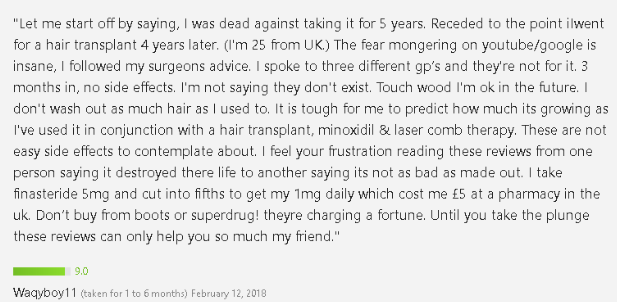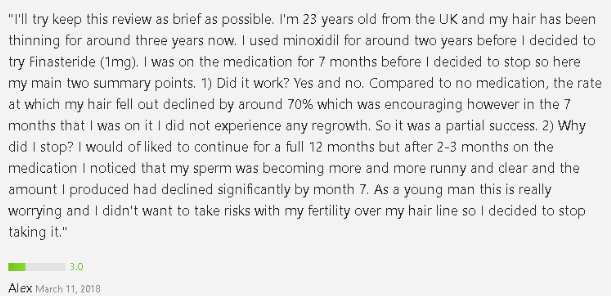
If you suffer from male pattern baldness, you have probably come across a treatment option by the name of Finasteride. While effective, it is important that you are properly informed before starting usage. After reading this informative article out, you can confidently decide along with your physician if Finasteride is right for you.
What is Finasteride?
Finasteride is a common prescription medication that many men use to help control symptoms of an enlarging prostate, which could lead to high-grade prostate cancer, and quite commonly, to help treat symptoms of male pattern baldness, such as a receding hairline or thinning of hair on certain parts of the head.
It is very effective at helping to manage symptoms of alopecia androgenetica (or androgenetic alopecia), more commonly known as male pattern baldness. It is very important that you understand this drug in detail before committing to consuming it by having a thorough discussion which your healthcare provider.
The Effects of Finasteride on Hair?
Finasteride is a medication known as a 5 –alpha-reductase inhibitor (5-AR inhibitor), a class of compounds which are able to prevent the conversion of the primary male sex hormone testosterone into the potent androgenic metabolite dihydrotestosterone, simply known as DHT most of the time.
Hair follicles contain large amounts of the androgen receptors on their surface, which is the target of both male sex hormones. While either of the hormones is free to interact with the surface of the receptor, testosterone will not elicit any notable type of effect on hair.
Finasteride Works As A DHT Blocker
When it comes to DHT it does the following:
It binds to the hair follicle and causes shrinkage of them. As a result, the necessary nourishment for hair to thrive is blocked, causing it to stop growing. In addition to this, DHT causes modification of normal hair growth cycles, so that the anagen phase (or active growth cycle) is significantly shortened, and the telogen phase is prolonged. During the telogen phase, hair growth is dormant and is why hair stops growing.
Finasteride, when consumed, helps to significantly reduce the production of DHT in the first place, which means that there is less of this hormone to interact with androgen receptors on the surface of the hair follicle. The reduced supply of this hormone means that hair growth can resume uninterrupted.
There is one major limitation to Finasteride’s utility, however, which is the fact that it cannot stimulate hair growth on parts of the scalp that are completely bald. There must be hair present, regardless of how thin it is.
Finasteride Treats Male Pattern Hair Loss
By definition, alopecia androgenetica is male pattern hair loss, even though it can also affect women. However, Finasteride is not the best course of therapy for women.
There are actually many different causes of hair loss, which are categorized based on their specific traits. Men with a genetic history of DHT sensitivity and male pattern baldness are the ones most likely to benefit from the use of Finasteride.
Finasteride Can Help Regrow Scalp Hair
DHT remains an important androgen for men, as it helps to maintain secondary sexual characteristics, such as body hair and the growth of facial hair. Since you are unlikely to experience hair loss in these areas as a result of male pattern baldness, when using Finasteride you will not experience enhanced hair growth in these areas, but rather a decrease. This is because DHT causes the growth of hair in these areas, and reducing its production via the use of Finasteride will, in turn, decrease the speed of hair growth in these regions.
On the scalp, the effect is seemingly different, as men who are more sensitive to DHT will benefit from controlling the inhibitory actions it has on hair follicles of the scalp. It is important that you use Finasteride while you have hair left, as it cannot resurrect dead hair follicles.
The Effects of Finasteride on Prostate Enlargement
An enlarging prostate, known medically as benign prostatic hyperplasia or BPH for short, is as the name suggests, the abnormal growth of the cells of the prostate, but more specifically an increase in their number. This is different from hypertrophy, which simply means an increase in size.
Hyperplasia is technically more worrisome, as an increase in the number of cells raises the risk of unwanted mutations occurring, leading to cancer. While most cases of BPH are benign, it can randomly at any time start to grow uncontrollably and be diagnosed with high-grade prostate cancer.
DHT is the known cause of an enlarging prostate, which is why Finasteride is accepted as an effective management therapy for the condition. However, what is unknown is the fact that estrogen may be the hormone that sets the growth into motion in the first place. As the body detects an increased level of estradiol in the blood, it attempts to compensate by producing more DHT. This is the beginning of the BPH cascade.
Propecia, Proscar And Other Brands And Generics
When Finasteride was approved by the FDA in 1992, it was originally marketed under the brand name Proscar. Later, in the year 1997 Finasteride was also given approval for the treatment of male pattern baldness and marketed under the brand name Propecia. Both brands were owned by Merck, and are the most well-known brands of Finasteride on the planet.
Regardless, there are now a number of lesser-known brands and generics, which share bioequivalence with the original brands but at a fraction of the cost. Other common generic brands include:
- Apotex Canada
- Dr. Reddy’s Laboratories, Inc.
- Mylan Pharmaceuticals Inc.
- Teva Pharmaceuticals USA, Inc.
- Accord Healthcare Inc.
- Ascend Laboratories LLC
- Exelan Pharmaceuticals, Inc.
- Finabald
- Fincar
- Prohair
Possible Finasteride Side Effects
Even though Finasteride is generally well tolerated by the majority of men that consume it for either a receding hairline or prostate enlargement, it is very important to be aware of possible side effects that you may encounter which could persist long after discontinuing the product and could make it unsuitable for your usage.
Frequently occurring side effects include:
Sexual Side Effects and Trouble Having an Orgasm
When sexual side effects occur, loss of interest in sex is a common complaint but is something that should be expected when you consider what the drug is all about. While testosterone is known as a hormone having both anabolic and androgenic effects (the masculinizing effects), DHT is a very potent androgenic hormone.
Inhibition of DHT results in symptoms consistent with reduced male sexual characteristics, including the slowed growth of body hair, decreased aggression and suppressed libido. The inability to orgasm can be related to decreased dopamine release in the brain, as the androgens and dopamine share a relationship beneficial to each other.
Another commonly associated adverse effect of finasteride? Poor erectile potency, as blood flow alone, is not the sole factor that determines the quality of an erection.
Swelling of Hands And Legs
Swelling of the hands and feet, medically referred to as peripheral edema, can occur randomly and without warning, but is more likely in persons with complications of kidney disease, or if using medication to manage blood pressure.
But why does this occur?
Primarily, it occurs due to disturbances in the balance of the important electrolyte minerals, sodium, and potassium. Under normal circumstances, a hormone by the name of aldosterone is secreted, which helps to ensure that the correct concentration of these electrolytes is present in the blood.
Testosterone and DHT help to regulate this hormone, which in turn modulate blood pressure and fluid concentration within blood vessels. When Finasteride inhibits DHT, the result can be excessive retention of sodium, which prevents the removal of excess water from the body, so swelling of the limbs occurs.
Though not usually serious, it is something that needs to be kept in the back of your mind to discuss with your physician to prevent it from occurring altogether.
Dizziness And Headaches
While you may believe that dizziness and headaches occur side-by-side, or are associated in some way, they can have distinctly different causes, especially when triggered by Finasteride consumption. When it comes dizziness, it is likely temporary postural hypotension that is the culprit. This is a type of short-lived drop in blood pressure that occurs when you change position too rapidly, such as when you go from sitting to standing or from laying on the bed to standing.
When your position changes, blood may not start to circulate at the same speed, but rather remain pooled in your lower extremities. As a result, you experience dizziness until circulation of blood is able to reach back to your brain.
On the other hand, how are the headaches caused?
As it turns out, headaches may have more to do with this increased estrogen levels, courtesy of suppressed DHT production. DHT has a controlling influence on the female hormone estrogen, keeping its production low so as to not cause adverse effects from manifesting in men.
With DHT production reduced as much as 70% while on Finasteride, estrogen dominance can easily occur due to the uncontrolled conversion of testosterone into the female hormone. Estrogen can also stimulate the stress hormone cortisol, which then predisposes you to develop stress-related headaches and migraines much more easily.
A study conducted by the North American menopausal society confirmed that most girls first experience a headache during the same year that they first see their menstrual period.
Reviews: 10 Things Customers Are Saying About It
Before considering what people are talking about Finasteride, you need to realize that this is not a supplement that you can randomly pick up online from a website such as Amazon, but rather one that must be initially prescribed by a health care physician.
There is a wide range of customer reviews regarding Finasteride, as some men swear by it while orders do not wish it on their worst enemy.
Here is what some people are saying:


Finasteride appears to work for men of all ages, and may be better if used soon after here loss or thinning of hair is noticed. As the user above indicated, side effects for him were almost nonexistent, but also states that he believes the standard dose used for male pattern baldness is higher than necessary.



The user referenced in the review above has had favorable results even after using Finasteride for 11 years. However, he indicates that he uses it just two times per week, which is far lower than the recommended once-daily dosing and is not advised owing to the short half-life of the drug.

Symptoms of male sexual dysfunction are relatively common in men using Finasteride and are the reason many other potential candidates opt out of using it completely. The user indicates that he had no prior medical issues, but still suffered significant effects from short-term usage.

As the user above indicated, he appears to be suffering from symptoms known as post-Finasteride syndrome, in which adverse effects persist long after discontinuing the drug. There is even an active petition to have the drug banned for the same reason, as it can be unpredictable years after treatment has been stopped.

While many men either notice effect or don’t, there are others that fall in the middle ground. As referenced above, the user notes that his hair loss has not worsened, and he has even noticed a decrease in the rates of falling hair, but regrowth is also not noticeable. Added to this fact is the worrying case of seemingly decreased semen quality and fear or disrupted and impaired fertility.

This review indicates no effect whatsoever, but user believes it may be due to constant changes in Finasteride brand. While it is true that different manufacturers may have small variances in product quality, it should not be significant enough to be a problem.
What Happens If You Miss A Dose Or Overdose?
Owing to the busy lifestyles most of us live, it is very likely that you will miss the occasional dose of Finasteride at its scheduled time. It is often taken once per day, at approximately the same time daily in an effort to help maintain a steady blood level of the drug.
If you miss a dose:
Do not take a double dose. Rather, depending on how long it was since you took your last dose, you will either need to adjust your timing or wait for the next dose. So, for example, if you normally take your dose before bed, but remembered upon waking the next day, you can take it at this time but need to change your daily dosing to this time.
Alternately, you could wait until the evening to take your next dose and continue as normal from there on.
In the event that you accidentally overdosed:
Due to the fact that Finasteride overdoses rarely occur, there is limited data available on how to handle it. In many cases, however, dealing with overdose usually entails management of side effects as they manifest. For example, should fluid disturbances be detected, an intravenous line and electrolytes may be administered to help correct the balance. Rarely, stomach irrigation may be used if the patient makes it to a hospital or Poison Control Center shortly after ingestion. This technique involves the insertion of a tube into the stomach, where its contents are pumped out.
Where to buy Finasteride
Finasteride is a prescription only medication and must be recommended by your doctor before you can legally obtain some. Thus, it can easily be found in any pharmacy, given that you have a prescription from a doctor.
Besides this channel, it is also possible to buy this drug online without a prescription. However, you are not guaranteed to get genuine Finasteride in either branded or generic versions, as counterfeiting is very possible when buying from unknown sources. Some international countries may have lax drug laws that allow it to be picked up without a prescription, but this should only be done if you have used it in the past.
In addition to this, it is never a good idea to self-medicate with medications this powerful and which carry the risk of serious side effects, especially in uninformed persons. You should consult your doctor or a hair loss specialist if you would like to discuss your suitability for using Finasteride.
Final Thoughts
Finasteride remains one of only two treatments approved by the FDA for the management of male pattern baldness and is generally very effective by men who use it. However, as with everything else, it will not work for everyone and carries a possibility of adverse effects manifesting during usage. At the end of the day, it can make a world of difference in helping to stop a receding hairline but it should not be regarded as a miracle cure for ending hair loss once and for all.
Recommended Articles For You
Managing Alopecia – Guide for Fighting Receding Hairline
